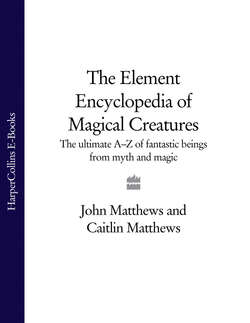Читать книгу The Element Encyclopedia of Magical Creatures: The Ultimate A–Z of Fantastic Beings from Myth and Magic - John Matthews - Страница 287
BULL
ОглавлениеThe domestication of cattle helped our ancestors move from being nomadic hunter-gatherers dependant upon following migratory herds of animals to becoming settled farmers. Cows might give their milk and oxen their gentle but powerful strength to pull carts and ploughs, but people still retained respect for the bull because of its limitless virile power. One of the earliest ritual implements, said to mimic the sound of the bellowing call of the bull, the bullroarer, is universally used to summon spirits. Domestic cattle descend from the oriental aurochs, a creature so powerful that the Babylonians and Assyrians thought it impossible to tame without divine assistance. The chariot of the Hittite sun god Samas was pulled by bulls. They also pull the chariot of the Roman Jupiter, Dolichenus, who was responsible for the weather.
The Israelites set up their golden calf when Moses retired to commune with God and receive the Ten Commandments. This idolatry, perhaps retained from their time in Egypt, caused Moses to lose his temper, but it appears that the Israelites were searching their ancestral memory for a divinity that was strong and dependable in a time of great stress and uncertainty. In Sumerian myth, the creator Anu made the Bull of Heaven, Gudanna; the celestial bull was the one who ploughed the furrow of the heavens. The insatiable virility of the bull was one of the qualities worshipped in the Sumerian god, Dumuzi, who was responsible for crops and herds. As the consort of Inanna, the Queen of Heaven, he needed to satisfy her desires. This is reminiscent of the insatiable desire of Queen Pasiphae for the sacred bull in Cretan myth.
The Bull of Minos was the sacred bull from the sea, sacred to Poseidon, sent to Minos as a suitable sacrifice to the sea god. Instead of sacrificing it, Minos chose to keep it. Poseidon’s punishment for this act of impiety fell upon the whole Cretan royal family. Such was Pasiphae’s desire for the sacred bull, that the artificer Daedelus had to create a wooden cow within which she might lie, so that she could satisfy her desires and not be crushed by the bull’s great weight when it coupled with her. The outcome of this union was the Minotaur, as the bull-leaping dances and games depicted upon the walls of King Minos’ palace at Knossos, Crete, remind us. After these terrible events, the bull went mad and became the object of Hercules’ eighth labour. He was able to lasso it with a rope and then stunned it with his club before bringing it alive to Mycenae. The bull wandered along the coast of the Peloponnese before it came to Marathon where Theseus caught it, sacrificing it to Apollo. In this way, Theseus killed both the bull-headed Minotaur and the bull that fathered the half-human monster. These wild games remain a potent feature of Mediterranean life in the bull-running festival of Pamplona in Spain and the many bullfights which retain the mystique of the ancient bull mysteries. These sacred games were utterly at odds with the wild-beast combats designed by the Romans, who aimed to entertain the crowd with as bloody a spectacle as possible.
In the Hindu culture of southern India, the bull is one of the animals which was once the guardian of marriageable young people. Young men showed their preparedness to marry by engaging in a ritual contest called ‘embracing the bull’. The best bulls were driven in a stockade where the youths would leap on to the bull’s back, so demonstrating their courage. This display of machismo was not exclusively a male prerequisite, for young Hindu girls were once expected to tend a bull for a whole year to demonstrate that they were ready to take on the task of tending a demanding husband.
The Egyptian cult of the bull is seen in the rites of Apis, who is described by Herodotus as a ‘black bull with a triangular white blaze upon his forehead, with the shadow-shape of a falcon upon his back, and a beetle upon his tongue’. Apis was regarded as the conception of his cow-mother from a ray of the moon. He was seen as the avatar of Osiris, and ‘the second life and servant’ of Ptah, the creating god. The Roman poet Virgil describes the contemporary sacrifice of a bull in Canopus, Egypt, which was poleaxed and laid enclosed in a temple with four windows open to the four winds:
Soon the flesh of the animal’s body begins to heat and to ferment…A cloud of insects emerges from it, crawling, vibrating their wings and launching into the air with a great noise.
This sacrifice was made before the coming of the swallows every year. The bull god Menwer was worshipped at Heliopolis while the bull god Bacchis was venerated at Hermonthus.
In Mithraic mythology, the central liberating act of the Persian god Mithras is his slaying of the bull, as a symbol of his supremacy over his animal nature. Mithraic candidates to his cult were initiated by standing in the taurobolium, a pit over which is laid a grating, through which trickled down the blood of the bull, so that they might partake of the mystery of Mithras’s liberation.
